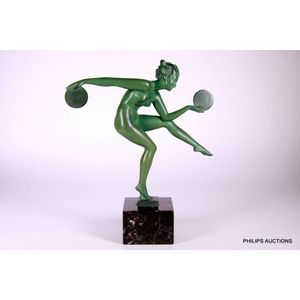Art Deco Dancer by Derenne
You must be a subscriber, and be logged in to view price and dealer details.
Subscribe Now to view actual auction price for this item
When you subscribe, you have the option of setting the currency in which to display prices to $Au, $US, $NZ or Stg.
- Cold Painted - This is term applied to so-called "Vienna bronzes" manufactured in that city starting in late part of the 19th century, and it continued in the early 20th century, but was also used by sculptors working in other areas of Europe at the time..
Traditionally bronzes are finished by treating them with various acids and chemicals and heats, and the patina is incorporated into the surface of the piece.
A cold-painted bronze is decorated with oil paints. The color was not fired, hence the term "cold painted". Reputedly the painting was carried out mainly by women working at home, a typical cottage industry. - Circa - A Latin term meaning 'about', often used in the antique trade to give an approximate date for the piece, usually considered to be five years on either side of the circa year. Thus, circa 1900 means the piece was made about 1900, probably between 1895 and 1905. The expression is sometimes abbreviated to c.1900.
- Spelter - Spelter was the name given to an alloy of zinc and brass or copper used in the 19th century for statuary and lighting. It is a brittle bluish-white metal. It was used as a cheap replacement for bronze, but being brittle easily breaks and can't be repaired. When finished it can often be mistaken for bronze, but if discreet a scratch on the base displays shows a greyish colour, the metal is spelter, if a golden colour the metal is most likely bronze.
- Incised - A record of a name, date or inscription, or a decoration scratched into a surface, usually of a glass or ceramic item with a blunt instrument to make a coarse indentation. Compare with engraving where the surface is cut with a sharp instrument such as a metal needle or rotating tool to achieve a fine indentation.
- Art Deco Period - The Art Deco period was a cultural movement that emerged in the 1920s and 1930s, and was characterized by its emphasis on modernism, luxury, and elegance. The name "Art Deco" comes from the Exposition Internationale des Arts Décoratifs et Industriels Modernes, a large exhibition held in Paris in 1925 that showcased the latest trends in decorative arts.
Art Deco was a reaction against the ornate and elaborate styles of the previous era, and reflected a new modern sensibility. It was characterized by streamlined, geometric shapes, bright colours, and the use of new materials such as chrome, glass, and Bakelite. Art Deco designers sought to create a sense of luxury and sophistication, often incorporating expensive materials such as ivory, marble, and rare woods.
Art Deco had a significant impact on a wide range of artistic fields, including architecture, fashion, graphic design, and interior design. Some of the most iconic examples of Art Deco architecture include the Empire State Building in New York City, the Hoover Building in London, and the Palais de Chaillot in Paris.
The Art Deco period came to an end in the 1940s, as World War II and changing cultural trends led to a shift in artistic styles. However, Art Deco remains an important influence on design and art, and continues to be celebrated for its modernist sensibility and glamorous aesthetic.
This item has been included into following indexes:
Visually similar items

Ettore Sottsass, Le Strutture Tulmano, c. 1979, laminate over pressboard, enameled steel, enameled aluminium, glass, Memphis for Studio Alchimia. Height 117 cm glass top length 61 cm. Depth 61 cm. Provenance: Private Collection, Sydney

Michele de Lucchi, Sinerpica lamp, Italy, 1980, enameled metal, Memphis for Studio Alchimia. Height 73 cm. Literature: Studio Alchimia Bau. Haus Art collection, manufacturer's catalog, unpaginated Il design in Italia Dell' Arredamento Domestico, Gramigna a

Victorian brass hanging light, rope twist stem above rope twist pear, set with white to green etched shade, height 89 cm

A French wrought iron chandelier, circa 1960s-70s, rococo inspired and of scrolling birdcage form, with five 'S' form arms supporting small pans with electric candles. Height 72 cm
